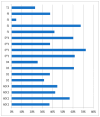Analysis of IVIM Perfusion Fraction Improves Detection of Pancreatic Ductal Adenocarcinoma
- PMID: 38534992
- PMCID: PMC10969450
- DOI: 10.3390/diagnostics14060571
Analysis of IVIM Perfusion Fraction Improves Detection of Pancreatic Ductal Adenocarcinoma
Abstract
The purpose of this study was to evaluate whether intravoxel incoherent motion (IVIM) parameters can enhance the diagnostic performance of MRI in differentiating normal pancreatic parenchyma from solid pancreatic adenocarcinomas. This study included 113 participants: 66 patients diagnosed with pancreatic adenocarcinoma and 47 healthy volunteers. An MRI was conducted at 1.5 T MR unit, using nine b-values. Postprocessing involved analyzing both conventional monoexponential apparent diffusion coefficient (ADC) and IVIM parameters (diffusion coefficient D-pure molecular diffusion coefficient, perfusion-dependent diffusion coefficient D*-pseudodiffusion coeffitient, and perfusion fraction coefficient (f)) across four different b-value selections. Significantly higher parameters were found in the control group when using high b-values for the pure diffusion analysis and all b-values for the monoexponential analysis. Conversely, in the study group, the parameters were affected by low b-values. Most parameters could differentiate between normal and cancerous tissue, with D* showing the highest diagnostic performance (AUC 98-100%). A marked decrease in perfusion in the patients with pancreatic cancer, indicated by the significant differences in the D* medians between groups, was found. In conclusion, standard ADC maps alone may not suffice for a definitive pancreatic cancer diagnosis, and incorporating IVIM into MRI protocols is recommended, as the reduced tissue perfusion detected by the IVIM parameters is a promising marker for pancreatic adenocarcinoma.
Keywords: diagnostic accuracy; diffusion-weighted imaging; intravoxel incoherent motion; pancreatic ductal adenocarcinoma; perfusion-dependent diffusion coefficient.
Conflict of interest statement
The authors declare no conflicts of interest.
Figures
References
LinkOut - more resources
Full Text Sources



